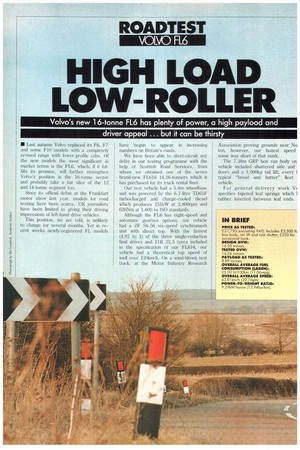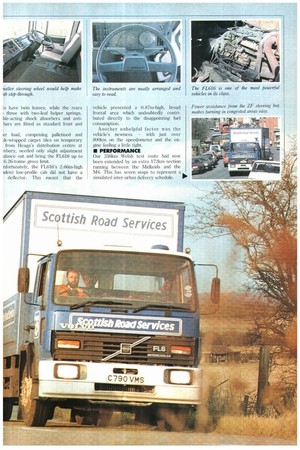HIGH LOAD LOW-ROLLER
Page 34

Page 35

Page 36

Page 38

If you've noticed an error in this article please click here to report it so we can fix it.
Volvo's new 16-tonne FL6 has plenty of power, a high payload and driver appeal ... but it can be thirsty
• Last autumn Volvo replaced its F6, F7 and some F10 models with a completely revised range with lower-profile cabs. Of the new models the most significant in market terms is the FL6, which, if it fulfills its promise, will further strengthen Volvo's position in the 16-tonne sector and probably take a fair slice of the 12 and 14-tonne segment too.
Since its official debut at the Frankfurt motor show last year, models for road testing have been scarce. UK journalists have been limited to ving their driving impressions of left-hand drive vehicles.
This position, we are told, is unlikely to change for several months. Yet in recent weeks newly-registered FL models have begun to appear in increasing numbers on Britain's roads.
We have been able to short-circuit any delay in our testing programme with the help of Scottish Road Services, from whom we obtained one of the seven brand-new F1,616 16.26-tonners which it has purchased for its truck rental fleet.
Our test vehicle had a 5.8m wheelbase and was powered by the 6.7-litre TD611; turbocharged and charge-cooled diesel which produces 151kW at 2,800rpm and 620Nm at 1,600 to ISO standards.
Although the FL6 has eight-speed and automatic gearbox options, our vehicle had a '11.' S6-56 six-speed synchromesh unit with direct top. With the fastest (4.87 to 1) of the three single-reduction final drives and 11R 22.5 tyres included in the specification of our FL616, our vehicle had a theoretical top speed of well over 120km/h. On a wind-blown test track, at the Motor Industry Research Association proving grounds near Nu ton, however, our fastest speed some way short of that mark.
The 7.38m GRP box van body on vehicle included shuttered side and doors and a 1,000kg tail lift; every I typical "bread and butter" fleet vehicle.
For general delivery work Vi specifies tapered leaf springs which 1 rubber inserted between leaf ends. ls have twin leaves, while the rears three with two-leaf helper springs. ble-acting shock absorbers and antibars are fitted as standard front and ur load, comprising palletised and lk-wrapped carpet tiles on temporary from Heuga's distribution centre at !sbury, needed only slight adjustment alance out and bring the FL616 up to .6.26-tonne gross limit.
nfortunately, the FL616's 2.66m-high mien) low-profile cab did not have a deflector. This meant that the vehicle presented a 0.87m-high, broad frontal area which undoubtedly contributed directly to the disappointing fuel consumption.
Another unhelpful factor was the vehicle's newness — with just over 800km on the speedometer and the engine feeling a little tight.
• PERFORMANCE
Our 336km Welsh test route had now been extended by an extra 172km section running between the Midlands and the M4. This has seven stops to represent a simulated inter-urban delivery schedule.
Here, our FL616's fuel consumption dropped to 28.514/100km (9.9mpg).
In spite of its handicaps the test vehicle acquitted itself well and, although its fuel consumption was below par, it performed smoothly and with a rate of acceleration that will be hard to better.
With its power-to-weight ratio of 9.29 kW/tonne the FL616 is one of the most powerful 16-tonners on the market, bettered only by Ford's 16.24 Cargo. While it is very well suited for short to mediumhaul work, the TD61F charge-cooled engine will cruise along quite happily at the end of the green economy band at 2,400rpm in top gear and at maximum permitted speed on the motorway.
On the 84.6km M4 stretch between Membury and Aust services it returned 23.91it/100km (11.82mpg) in an identical time to the 128kW Leyland Freighter and 125kW Mercedes-Benz 1617 — the fastest over this short distance CM November 9, 1985).
Some allowance for its high frontal area has to be made when comparing its fuel consumption with these two, which both returned 18.61it/100km (15.2mpg).
When CM tested the early F616 in box-bodied form but with the 128kW (172hp) TD608 non-charge-cooled engine, it returned 2 3. 081itil 00km (12.2mpg) on the M4 stretch. Overall it achieved 22.81it/100km (12.36mpg) at an average speed of 59.2kmih (36.8mph).
Journey times of the new vehicle over the rest of the route were also quite quick, although similar to other makes previously tested.
Despite its newness the Volvo TD61F had a marked liveliness which is reflected in its extremely rapid hill climb times. Over the Monmouth by-pass it was only 10 seconds behind the 2 minutes 42 seconds of the 16.24 Cargo with its 186kW Cummins LT10 engine, and 17 seconds ahead of the other 16.26-tonne 'quickie' here, the MAN 16.170F. It was 43 and 18 seconds faster respectively on the Wantage hill than the Mercedes and the Freighter and a full minute up on previous F616 tested.
Credit must be paid to the wellmatched driveline, particularly towards the lower end of the gear ratios where the FL6 pulls strongly.
On the test hills at MIRA it showed fine gradeability, pulling off the 25 per cent gradient with apparent ease.
Much of the time the gears could be selected fairly easily thanks to a lightly balanced clutch pedal and comfortable lowangled accelerator pedal. Only the detente between first and second gear and the centre position in the neutral gate caused problems. This felt very uncertain and caused the early notchy feeling and occasional selection of reverse instead of second gear.
At 901(m/h on the motorway, a harsh vibration arising from the front of the vehicle could be felt at the floor and steering wheel. As yet there is no explanation for it, but Scottish Road Services is currently investigating.
On MIRA's ride and handling circuit, where cornering speeds can be increased beyond those on normal roads, it produced excessive but not alarming roll. Around the route the box-bodied FLOP with its 'higher centre of gravity also produced much more roll than we would normally experience, but it was held well in check by the long leaf springs and anti-roll bars fitted to both axles.
• PAYLOAD With a chassis cab kerb weight of exactly five tonnes, the FL616 on this wheelbase offers an impressive 1L26-tonne body!payload allowance. This is 250kg less than the 1615 Cargo and Dodge Commando 16.26 tonners and just 100kg behind the clear market leader, the Freighter 1617.
• CAB The 'F' stands for forward control and 'L' is for low-profile cab, and it is here the FL6 scores most highly. It is mounted further forward of the front axle than the previous model and is easier to enter. With such low wide steps, well-positioned grab rails and doors which open to a full 90 degrees, getting into the driver's seat is easy, making the cab ideal for multi-drop delivery work.
By bringing the cab slightly forward Volvo has been able to make the engine cowl to be stepped down at the front. The company says this gives easy crosscab access. Unfortunately, the large steering wheel gets in the way. If this were made smaller it would allow easier movement, but at the moment the best way for the driver to leave his seat is via the vehicle's offside.
The driver's standard suspension seat is fully adjustable, well-contoured and comfortable enough for short-delivery work. While the back rest gives good lumbar support, the taper-sided seat base becomes uncomfortable on long continuous journeys.
Volvo's squat-looking cab affords wide dear views to the front and sides. The small kerb-side windows are a mere cosmetic exercise though, and at night only provide a source of distraction as lights flash into the cab through them.
Footwell space is restricted to the left of the steering column and the standard exhaust brake, which is only really effective over 2,200rpm, has its button placed in the most awkward position — too far back and to the right to reach comfortably with the heel.
Instrument layout is neat and well thought out. At night it provides a very pleasant and colourful display with just the right intensity. Only the main-beam warning light spoils it by being too feeble.
Our test vehicle appeared to have a fault which caused the small light on the fuel gauge to flicker and a buzzer to go off whenever the footbrake, indicators, or headlights were operated.
Windscreen wipers have a good spread, with a very efficient four-point wash spray on each one.
The FL616's kerb-to-kerb turning circle of 22.28m (73ft) is in overall terms, large, but about average for this type of vehicle. However, the powered assistance of the ZF steering box makes turning in congested areas easy enough.
• SUMMARY Although 12 and 14-tonne FL rigid models are on offer, it is at the 16.26 tonne mark that the FL is expected to have the most impact. It offers a very wide range of specification with six wheelbases, three final drives, six or eight-speed manual or automatic transmissions, and steel or air suspension from which to choose.
In the form tested • a roof defied' would certainly have improved fuel cc sumption (Volvo offer one for £180) anc well run-in engine would have helped too However, its good 11.26-tonne ho payload figure, its strong, flexible pi fortnance and high level of driver appi might overcome any resistance caused its non-spectacular return on fuel.
At £22,000 the FL616 is £660 cheap than a comparable Mercedes-Benz 16 and only 2150 dearer than the clear an ket leader, the Leyland Freighter.


























































